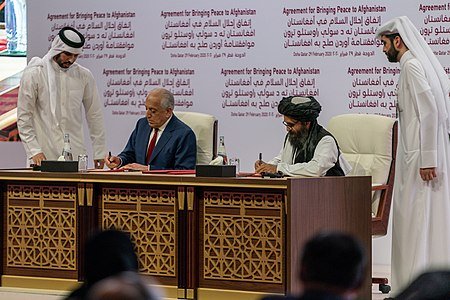On February 29, 2020, the United States and the Taliban signed a historic agreement aimed at ending the 18-year war in Afghanistan, America’s longest conflict. The deal, which came after months of negotiations, outlined the conditions for the withdrawal of U.S. troops from Afghanistan in exchange for security guarantees from the Taliban.
The agreement marked a significant milestone in the efforts to bring peace to Afghanistan, a country ravaged by decades of conflict and instability. It was hailed as a potential breakthrough that could pave the way for intra-Afghan negotiations and a political settlement. However, the path to lasting peace and stability in the region remained uncertain.
Under the terms of the agreement, the U.S. committed to reducing its military presence in Afghanistan from approximately 13,000 troops to 8,600 within 135 days. The remaining troops were to be withdrawn within 14 months, subject to the Taliban’s fulfillment of their commitments, including preventing terrorist groups from using Afghan soil to threaten the security of the U.S. and its allies.
In return, the Taliban agreed to prevent any group or individual, including al-Qaeda, from using Afghan territory to threaten the security of the United States and its allies. They also committed to engaging in intra-Afghan negotiations and working towards a comprehensive ceasefire.
The agreement was not without its critics. Some argued that the U.S. was making concessions to the Taliban without ensuring sufficient guarantees for the protection of human rights, particularly for women and minorities. Others expressed concerns that the Taliban might not uphold their end of the bargain and that the deal could ultimately lead to a power-sharing arrangement that excludes certain groups.
Despite the skepticism, the U.S.-Taliban deal was seen as a potential turning point in the Afghan conflict. It provided an opportunity for the Afghan government and the Taliban to engage in direct negotiations and find a political solution to the ongoing violence. However, the road to peace was fraught with challenges.
One of the major obstacles to the implementation of the agreement was the lack of trust between the Afghan government and the Taliban. The Afghan government was not a party to the negotiations and expressed reservations about the deal, arguing that it did not address the root causes of the conflict and could undermine the democratic gains made in the country over the past two decades.
Another challenge was the continued violence and attacks by the Taliban. Despite the agreement, the Taliban carried out numerous attacks, targeting Afghan security forces and civilians. This raised doubts about their commitment to a peaceful resolution and highlighted the complexities of the situation on the ground.
Furthermore, the COVID-19 pandemic added another layer of complexity to the implementation of the agreement. The outbreak disrupted the peace process and hindered efforts to hold intra-Afghan negotiations. It also raised concerns about the ability of the Afghan government to effectively respond to the health crisis and maintain stability in the country.
As the deadline for the U.S. troop withdrawal approached, there were growing concerns about the potential consequences of a hasty exit. Critics argued that a premature withdrawal could create a power vacuum and lead to a resurgence of violence and the re-emergence of terrorist groups.
Despite the challenges and uncertainties, the U.S.-Taliban deal represented a significant step towards peace in Afghanistan. It opened the door for direct negotiations between the Afghan government and the Taliban and provided an opportunity to address the underlying causes of the conflict.
However, the road to lasting peace and stability in Afghanistan remains long and arduous. It requires the commitment and cooperation of all parties involved, including the Afghan government, the Taliban, and the international community. It also necessitates addressing the root causes of the conflict, promoting inclusive governance, and ensuring the protection of human rights.
Only time will tell whether the 2020 US-Taliban deal will lead to a sustainable peace in Afghanistan. The challenges and complexities of the situation cannot be underestimated. Nevertheless, the agreement represents a significant step towards ending the war and bringing stability to a country that has suffered for far too long.
SEO Excerpt:
The 2020 US-Taliban deal signed on 29th February 2020 marked a historic agreement aimed at ending the 18-year war in Afghanistan. While it was seen as a step towards peace, the implementation faced challenges and criticism. This article explores the conditions of the deal, its significance, and the road to lasting stability in Afghanistan.

